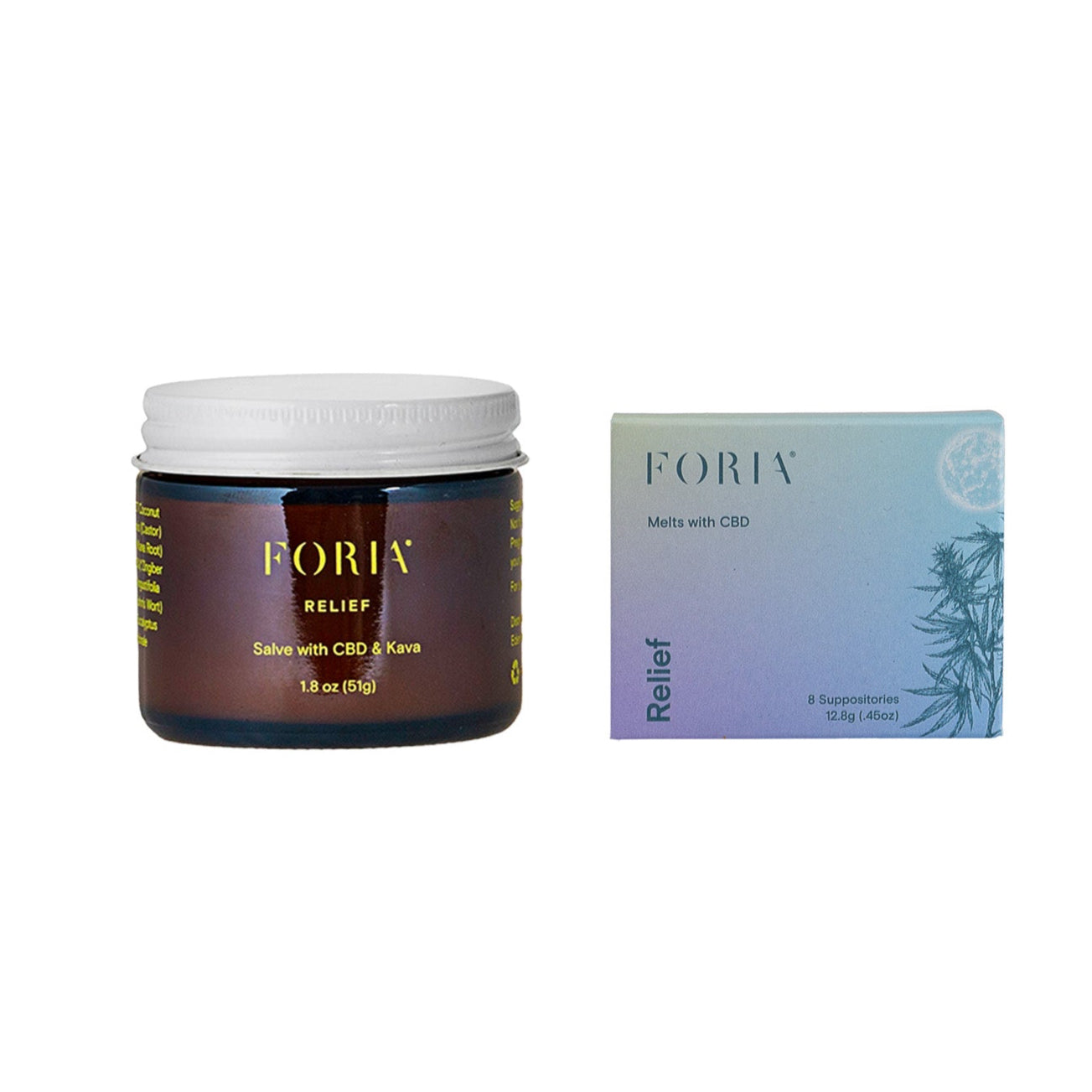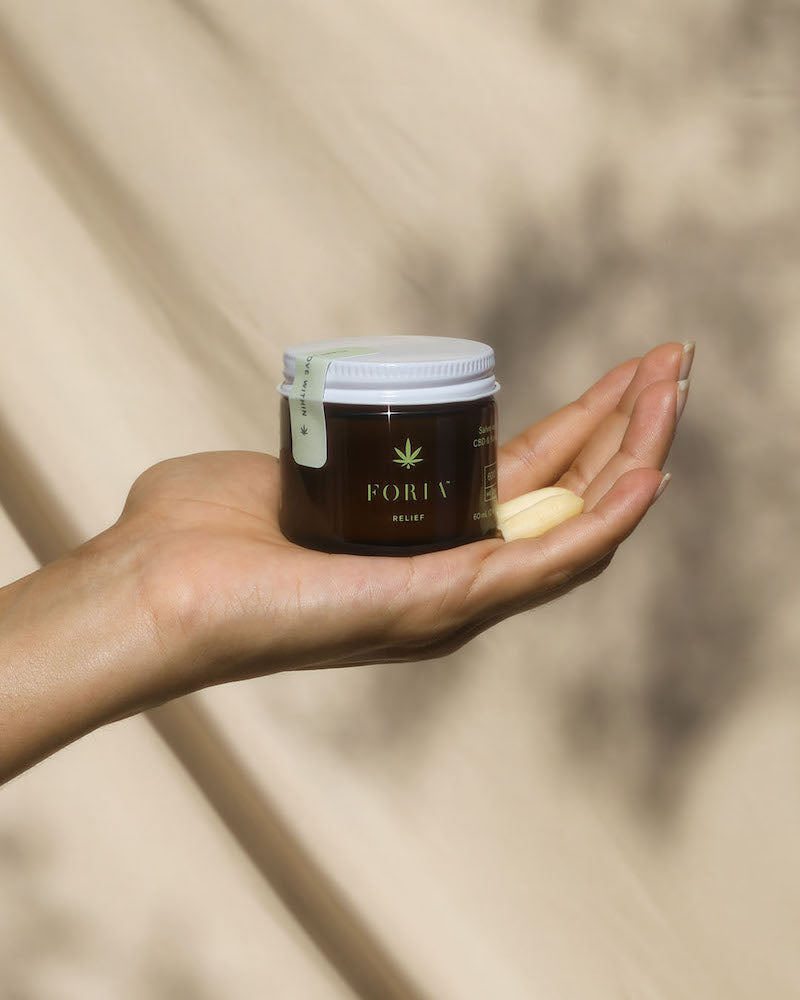Since the dawn of time, people who bleed have been expected to endure days of pain and inconvenience every month – with limited resources to help. (You might ask yourself whether people who don’t bleed would ever put up with this.) Worldwide, studies show that between 50% and 85% of people with uteruses experience menstrual health challenges, with a range of symptoms from mild discomfort to debilitating pain and nausea. Conditions like endometriosis and PCOS may greatly worsen menses pain, and getting a diagnosis is often an uphill battle.
Menstrual pain can be a mere annoyance, or it can greatly disrupt our lives. Why are our options for alleviating it so limited, even in this modern age?
Historically speaking, pain experienced by women and people with uteruses has often been dismissed as unimportant, exaggerated, or even a divine punishment for original sin – which may partly explain the lack of available options. Midol, the last commercial product specifically designed to address period pain, was released in 1911, and newer innovations often involve side effects that can make the cure worse than the problem.
We created our all-natural and organic Relief collection to address the lack of new innovations for period support. But the world still has a long way to go.
Let’s dig into the history of menstruation, and how to deal with painful periods today.

First of All, What Causes Menstrual Pain?
Despite how few solutions our society offers for menstrual pain, experiencing painful periods is extremely common, and a few factors are at play associated with varying levels of discomfort during menstruation.
Stress
These days, there is no shortage of stressors — and also no shortage of psychological experiences attributed to stress. And a painful period is no exception.
While stress may play a role in an unusually uncomfortable period, the pain you feel is by no means manifested or ‘all in your head.’ The effects of stress on our bodies are real. It’s why it’s essential to find ways to manage stress that work for us.
When our main stressors included fighting off bears or running from dangers in the wilderness, the stress hormone cortisol triggered a physiological response to help our body respond to the threat at hand. Cortisol can shift metabolic function to provide access to immediate energy, narrow the arteries, and boost the heart rate to increase blood flow — all vital when prepping the body to fight-or-flight its way to safety.
But, when facing more common current stressors like looming deadlines, insecurities, or relationship struggles, the effects of cortisol on the body aren’t quite as useful. They can ultimately take a toll on our bodies and even affect our cycles.
This is because our reproductive hormones follow a natural cycle of peaks and drops, and these hormonal shifts are responsible for our menstrual cycle. The hypothalamic-pituitary-ovarian axis is the line of communication between the brain and the ovaries that help regulate our cycles. But, when cortisol is released from the adrenal glands, it can interfere with these communication pathways, ultimately messing with the flow of things.
For some, cortisol may modulate pain perception, contributing to a heightened sensitivity to pain. Stress can also lead to muscle tension, spasms, or swelling. And since uterine muscle contractions already cause period cramps as we shed our uterine endometrial lining, the effects of stress can make these cramps (also known as dysmenorrhoea) even worse.
The prominent brain-gut connection means that we tend to feel stress acutely around our stomach. This may look like bloating or nausea — symptoms that you may already know all too well are associated with periods, too. It’s no wonder that stress can exacerbate these discomforts for an even crummier period.
Hormonal Changes
Hormonal changes are a natural part of the menstrual cycle — but these normal shifts in hormone levels can also affect the mood and be the culprit of discomfort during our periods.
Each phase of our cycle — from our periods to ovulation and everything in between — is controlled by the hypothalamic-pituitary-ovarian axis. The hypothalamus and pituitary gland in the brain release FSH and LH, and these hormones serve as signals to the ovaries that direct the production and release of estrogen and progesterone.
FSH levels are the highest right before ovulation, while estrogen and progesterone levels drop at the start of the period, which then signals the brain to produce more FSH and GnRH hormones. These hormonal fluctuations throughout the month can cause mood swings, bloating, tiredness, acne, or skin tenderness — as many of us are already intimately familiar with (perhaps more intimately than we’d like to be).
Plus, when the uterus sheds its lining each month as menstrual blood, our bodies produce hormone-like chemicals known as prostaglandins. Prostaglandins promote the contracting of uterine muscles to support the discharge of unneeded endometrial lining, but these muscle contractions also lead to cramping and discomfort.
Since prostaglandins are associated with swelling around the pelvic area, higher levels of this chemical are associated with worse menstrual cramps, nausea, and overall discomfort. In short: the parts of our period we’re not usually stoked about.
Some Medical Conditions
Certain medical conditions may be at the root if you experience consistently severe or worsening period pain month in and month out. Endometriosis, uterine fibroids, pelvic inflammatory disease, or cervical stenosis are all potential conditions that can affect your cycle and increase period pain.
If extreme dysmenorrhoea is interfering with your daily activities during your period or becoming more painful each month, it is best to check in with your gynecologist to see if a medical condition is causing your period pain.
Have Periods Always Been Painful?
While the natural shift and cycle of hormone levels during menstruation have always led to discomfort for many uterus-having folks, extremely severe period pain is not something you should have to suffer through in silence.
Are you wondering how our blood-shedding ancestors managed their periods from the first day of menarche (first period) to menopause, and what methods we can use today to guide us through the hardest of heavy days? Let’s get into it.
Wandering wombs and menstrual huts: periods in history
When a woman has a discharge of blood which is her regular discharge from her body, she shall be in her impurity for seven days, and whoever touches her shall be unclean until the evening. – Leviticus 15:19
Popular beliefs around gynecological anatomy have always tended towards the strange, incorrect, and, dare we say, hysterical. (The root word of “hysteria” translates to “uterus”, though we often wonder if testerical might be more accurate.) The Greek physician Aretaeus, writing in the 2nd century AD, postulated that the uterus could actually detach itself and take a stroll around the body, causing any manner of “female complaints”. This belief appears to derive from much earlier cultural assumptions – and it persisted in Western medical circles for centuries.
Going even farther back than Aretaeus, the Old Testament claims that the pain of menstruation and childbirth are an illustration of original sin, Eve’s punishment for succumbing to temptation in the Garden, and therefore “just desserts” for people who bleed. This belief, held to a greater or lesser extent across the Abrahamic religions, may be a core reason why menstruation is considered taboo, and menstrual pain dismissed, even in modern, secular societies.
Additionally, many cultures worldwide practice menstrual sequestration, wherein women are expected to separate themselves from their communities during their periods, often staying in a designated place with other bleeding people, forbidden from participating in activities like food preparation. Members of these cultures often express mixed feelings about this custom; although the idea that a person is “unclean” during their period can be extremely hurtful and repressive, a week or so of rest and socializing may be very welcome – especially when it hurts (and it’s actually supportive of pelvic health in the long run).
And perhaps it could also be a time to share knowledge about what works, and what doesn’t, to ease cramps.

Pills and potions for period pain
Over the centuries, weird beliefs surrounding periods and the pain they can cause have informed some odd, extreme solutions, especially at the hands of medical professionals and purveyors of pharmaceuticals.
One of the oldest treatments for pain of all kinds is opium. Its derivative, morphine, was sold over-the-counter for menstrual pain as recently as the early 1900s. Even heroin began its life as a widely-available pain remedy, marketed by Bayer (yes, the aspirin people) in 1895. And there is no doubt that opiates work for pain; unfortunately, they’re also brutally addictive. Who knows how many people went to the drugstore for a little cramp relief and ended up with a hard-to-kick habit?
Also on the extreme end, healthcare providers throughout the ages have recommended surgeries for debilitating period pain – including removal of the ovaries, put forth by an American doctor in the mid-1800s. Oophorectomy would be effective, since it ends the menstrual cycle altogether; of course it also ends the possibility of fertility, and causes immediate menopause regardless of the age of the patient.
As science and technology advanced, options for addressing period pain did expand somewhat. Like oophorectomy, contraceptive pills can work by disrupting the menstrual cycle, and were approved by the FDA for debilitating cramps (though not, interestingly, for birth control) in 1957. However, the pill – especially the early pill, with its potent dose of hormones – comes with side effects that can be severe for some, including mood disturbances, loss of libido, and even risk of blood clots.
Fortunately, some progress has been made. Today, most people suffering from menstrual pain reach for NSAIDS – nonsteroidal anti-inflammatory drugs like ibuprofen, aspirin, and acetaminophen. They work by inhibiting the body’s production of prostaglandins, the inflammatory chemicals that cause cramping and work to expel the menstrual flow. NSAIDS aren’t perfect – they can cause kidney, liver or gastrointestinal problems when taken in excess – but they’re a definite improvement on earlier remedies like Warren’s Styptic Balsam, a formula popular in the 19th century, which consisted of sulphuric acid, turpentine and alcohol. (No thanks.)
Menstrual products
We would be remiss not to talk about the progress (or lack thereof) in the world of menstrual hygiene products. Thankfully, we have moved past bulky “feminine” napkins and unhelpful sanitary products of our menstrual history, but we have a long way to go.
Today people with vulvas have the option of traditional tampons and pads to menstrual cups and period underwear. But many of us know that buying any old product on the shelf can come with its fair share of risk factors. For people of reproductive age with menstrual periods, there are chemicals and additives to be aware of as we shop.
Here are a few to keep an eye out for:
- Rayon
- Cotton
- Titanium Dioxide
- Fragrance
- BPA
Luckily for us, we have at least a few options that are on the safer side.

Mother Nature and menstrual pain
For all the medical and religious authorities’ theorizing, people who menstruate have historically treated their period pain at home, using natural remedies and techniques that were widely available, often growing right out of the ground. And modern science often provides evidence that these remedies work.
Aspirin, for instance, is derived from the bark of the willow tree, which has been used to relieve all kinds of pain for millennia. Black cohosh, a flowering plant native to North America, was used by Native Americans to relieve gynecological complaints, and later became popular in Europe as well – and is still widely used today as a supplement. Cramp bark and black haw, different species in the same genus, have also been used to relieve cramps for centuries. Even common kitchen herbs like ginger, catnip, fenugreek, and chamomile find their way into teas that soothe when the cramps threaten to overwhelm.
In addition, techniques like vaginal steaming have been in use since long before Gwyneth Paltrow made them notorious. Ancient Mayan midwives had patients in their care sit over an herbal steam to relax their pelvises and improve circulation and blood flow. And abdominal massage, practiced worldwide, also has scientific support for easing cramps.
Although it’s always a good idea to consult with a doctor or OB-GYN (Doctor of Obstetrics and Gynecology) before beginning any new regimen, people who suffer from menstrual pain often report achieving relief via these very old practices — and one of the oldest is new again, owing to a recent bout of sanity in the legal realm.
Returning to Our Roots: What Is Cyclical Living?
Whether looking outward at the tides, the moon, the seasons — or inward at our body’s stunningly orchestrated hormonal shifts — it is clear that cycles play a major role in our world and our bodies. And cyclical living is all about embracing these cycles as fully as we can.
This is important because — in contrast to the daily rise and fall of hormones associated with penis-having-people that follow a daily cycle — reproductive hormones associated with uterus-having-people follow a longer, monthly cycle. And so, we cannot expect the same consistency in mood and motivation day in and day out — it's literally not how our bodies operate.
So, what can we do? Aside from pushing against a society that values productivity above all else with little room for nuance and pleasure, we can try to schedule our lives in a way that honors our own ebb and flow.
To live cyclically is to align our routine with the natural cycles around and within us. This can help us feel centered and balanced throughout the month, enhancing our mood, energy levels, confidence, and comfort during each phase of our cycle. This can help us feel more in control, more confident, and more ready to take on period pains and manage them as needed.
By tracking our cycles, we can prep for how our mind and body feel during each stage of our cycle and live in a way that honors and tends to those monthly ups and downs to reach a higher level of joy and fulfillment.
Navigating Our Cycles Like the Seasons
If you’re dipping your toes in cyclical living, consider each phase of your cycle as a season to help guide you through.
For instance, the week following our period serves as a rejuvenating springtime, when our estrogen levels are rising, and we tend to feel more energized and balanced. This could be a great week for social outings, planning, and committing time to your hobbies and passions .
Then, during ovulation (our cycle’s sexy summer), when estrogen and FSH levels peak and our libido and confidence may be higher than usual, this could be the time to socialize, put yourself out there, and seek out all the forms of pleasure you can dream of (we’ve got you covered here).
When PMS marks the start of our internal fall season, our energy levels tend to drop with the rise of progesterone and plateau of estrogen, so this is a week to be intentional about not pushing ourselves too hard and ensuring we have our surroundings set for whenever our period hits.
And then, during our period — the winter of the cycle — we can conserve energy as our hormone levels drop by keeping our calendar as clear as can be, cozying up with a hot tea, practicing deep breathing exercises, or settling into some reflective journaling time.
Give yourself the TLC you’re craving by planning more breaks into your work day if possible, setting time for nature walks and warm baths, using CBD for stress relief, engaging in some light aerobic exercise, or having an orgasm or three to help alleviate period pain and boost the mood.
By working with your body rather than against it, you may experience a heightened sense of control and an uplift in your mood as you give yourself grace and prepare for your low-energy days. Remember that everyone is different, so take some time to experiment and be gentle and forgiving with your expectations of yourself as you find your own personal cyclic groove.

Cannabis and cramps: the mother of them all
Cannabis and hemp have been part of human pharmacopeia for hundreds of years. Persian texts from the 9th century AD specifically describe cannabis’ effectiveness for uterine cramps, and sixteenth-century Chinese texts also recommend cannabis for menstrual disorders. And more recently, even Queen Victoria was famously prescribed cannabis for her problem periods, with her personal physician writing in The Lancet that cannabis “is one of the most valuable medicines we possess”.
Cannabis’ use for menstrual challenges is becoming more widely substantiated by science – and the anecdotal evidence is overwhelming. Worldwide and throughout history, untold numbers of people who bleed have reached for the herb when they felt cramps coming on – and given the absence of physical dependency, coupled with effective pain relief, it’s no wonder that this unassuming leafy shrub has remained so popular. Studies seem to show that CBD, the now-famous non-intoxicating cannabinoid, even works by inhibiting the production of prostaglandins – the same way NSAIDs do, without the tummyache or other side effects.
Of course, until recently cannabis and hemp were widely illegal, owing to some pretty questionable historical context. The decades of suppressed access to this remedy, and the fact that women's gynecological pain is one of the least prioritized areas of scientific research, highlights the unfortunate gender pain gap, and some researchers are looking to change that. With legalization has come exciting new research and more refined methods of use, providing improved access to relief to many.
You’re not alone!
Modern times have brought about a widespread relaxing of taboos when it comes to sexual health. Although most of us still aren’t comfortable moseying to the restaurant restroom with a tampon casually in hand (although we are hoping to see the end of that stigma, too!), the Internet has facilitated communication between people who bleed – and let many of us know that we’re not alone, we do have options, and that we shouldn’t put up with having our pain dismissed by the people who are supposed to look out for us.
Thankfully we have access to knowledge, both modern and ancient, that can help us find the tools we need – and deserve – for relief.
As much as we might secretly want to hide away in a tent during our periods, that isn’t an option for many of us. But if we educate ourselves on the options available, we might find ourselves in a very big tent indeed – one containing all the people who bleed, their stories and knowledge.
Sources:
Prevalence of menstrual pain in young women: what is dysmenorrhea? | PMC
Prior stress could worsen premenstrual symptoms, NIH study finds | National Institutes of Health
The gut-brain connection | Harvard Health
Cannabidiolic acid as a selective cyclooxygenase-2 inhibitory component in cannabis | PMC
Featured in this article
Want more? Sign up for our newsletter
By entering your email, you are agreeing to our terms and conditions and understand our privacy policy.










